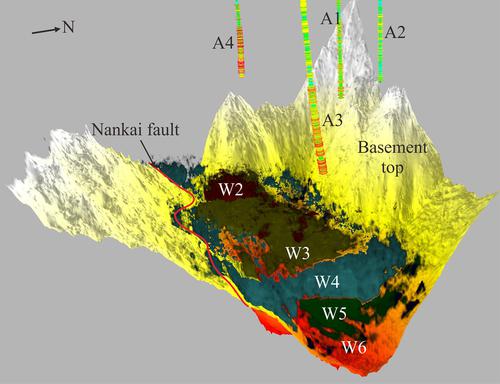当前位置:
X-MOL 学术
›
Acta Geol. Sinica Engl. Ed.
›
论文详情
Our official English website, www.x-mol.net, welcomes your feedback! (Note: you will need to create a separate account there.)
Distribution Prediction of Middle‐deep Lacustrine Source Rocks in Eocene Wenchang Formation in the Kaiping Sag, Pearl Mouth Basin
Acta Geologica Sinica-English Edition ( IF 3.3 ) Pub Date : 2021-01-08 , DOI: 10.1111/1755-6724.14629 Lianqiao XIONG 1 , Xiaojun XIE 1 , Zhao ZHAO 1 , Chunyu ZHANG 1 , Long WANG 1 , Jihua LIAO 1 , Lulu CAI 1 , Wei XU 1
Acta Geologica Sinica-English Edition ( IF 3.3 ) Pub Date : 2021-01-08 , DOI: 10.1111/1755-6724.14629 Lianqiao XIONG 1 , Xiaojun XIE 1 , Zhao ZHAO 1 , Chunyu ZHANG 1 , Long WANG 1 , Jihua LIAO 1 , Lulu CAI 1 , Wei XU 1
Affiliation

|
Oil and gas shows are rich in drilling wells in Kaiping sag, however, large oilfield was still not found in this area. For a long time, it is thought that source rocks were developed in the middle‐deep lacustrine facies in the Eocene Wenchang Formation, while there is no source rocks that in middle‐deep lacustrine facies have been found in well. Thickness of Wenchang Formation is big and reservoirs with good properties could be found in this formation. Distribution and scale of source rock are significant for further direction of petroleum exploration. Distribution characterization of middle‐deep lacustrine facies is the base for source rock research. Based on the sedimentary background, fault activity rate, seismic response features, and seismic attributes were analyzed. No limited classification method and multi‐attributes neural network deep learning method were used for predicting of source rock distribution in Wenchang Formation. It is found that during the deposition of lower Wenchang Formation, activity rate of main fault controlling the subsag sedimentation was bigger than 100 m/Ma, which formed development background for middle‐deep lacustrine facies. Compared with the seismic response of middle‐deep lacustrine source rocks developed in Zhu I depression, those in Kaiping sag are characterized in low frequency and good continuity. Through RGB frequency decomposition, areas with low frequency are main distribution parts for middle‐deep lacustrine facies. Dominant frequency, instantaneous frequency, and coherency attributes of seismic could be used in no limited classification method for further identification of middle‐deep lacustrine facies. Based on the limitation of geology knowledge, multi‐attributes of seismic were analyzed through neural network deep learning method. Distribution of middle‐deep lacustrine facies in the fourth member of Wenchang Formation is oriented from west to east and is the largest. Square of the middle‐deep lacustrine facies in that member is 154 km2 and the volume is 50 km3. Achievements could be bases for hydrocarbon accumulation study and for exploration target optimization in Kaiping sag.
中文翻译:

珍珠口盆地开平凹陷始新统文昌组中深层湖泊烃源岩分布预测
开平凹陷凹陷的油气藏丰富,但该地区仍未发现大油田。长期以来,人们认为始新世文昌组的中深湖相中发育有烃源岩,而井中没有发现中深湖相中的烃源岩。文昌组厚度大,储层性质好。烃源岩的分布和规模对于进一步勘探石油具有重要意义。中深湖相的分布特征是烃源岩研究的基础。根据沉积背景,分析了断层活动率,地震响应特征和地震属性。文昌组未采用有限分类法和多属性神经网络深度学习方法进行烃源岩分布预测。研究发现,在文昌组下段沉积过程中,控制下陷沉积的主要断层活动率大于100 m / Ma,形成了中深湖相的发育背景。与朱一depression陷中深层湖相烃源岩的地震反应相比,开平凹陷的烃源岩具有低频,连续性好的特点。通过RGB频率分解,低频区域是中深湖相的主要分布部分。主导频率,瞬时频率,地震的相干属性可以无限制地用于进一步识别中深湖相的方法中。基于地质知识的局限性,通过神经网络深度学习方法分析了地震的多属性。文昌组第四段中深湖相分布从西向东,是最大的。该成员中深湖相的面积为154 km2,音量为50 km 3。这些成果可以作为开平凹陷油气成藏研究和勘探目标优化的基础。
更新日期:2021-02-22
中文翻译:

珍珠口盆地开平凹陷始新统文昌组中深层湖泊烃源岩分布预测
开平凹陷凹陷的油气藏丰富,但该地区仍未发现大油田。长期以来,人们认为始新世文昌组的中深湖相中发育有烃源岩,而井中没有发现中深湖相中的烃源岩。文昌组厚度大,储层性质好。烃源岩的分布和规模对于进一步勘探石油具有重要意义。中深湖相的分布特征是烃源岩研究的基础。根据沉积背景,分析了断层活动率,地震响应特征和地震属性。文昌组未采用有限分类法和多属性神经网络深度学习方法进行烃源岩分布预测。研究发现,在文昌组下段沉积过程中,控制下陷沉积的主要断层活动率大于100 m / Ma,形成了中深湖相的发育背景。与朱一depression陷中深层湖相烃源岩的地震反应相比,开平凹陷的烃源岩具有低频,连续性好的特点。通过RGB频率分解,低频区域是中深湖相的主要分布部分。主导频率,瞬时频率,地震的相干属性可以无限制地用于进一步识别中深湖相的方法中。基于地质知识的局限性,通过神经网络深度学习方法分析了地震的多属性。文昌组第四段中深湖相分布从西向东,是最大的。该成员中深湖相的面积为154 km2,音量为50 km 3。这些成果可以作为开平凹陷油气成藏研究和勘探目标优化的基础。


























 京公网安备 11010802027423号
京公网安备 11010802027423号